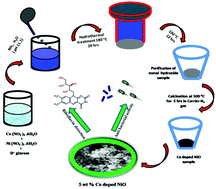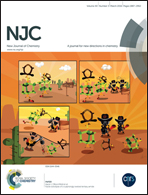Cerium doped nickel-oxide nanostructures for riboflavin biosensing and antibacterial applications†
Abstract
A sensitive electrochemical method for riboflavin (RF) detection based on Ce–NiO nanostructures was developed using a hydrothermal assisted chemical route. The created several oxygen vacancies on Ce doping are considered as the key factor for the magnificent electrocatalytic behavior of the Ce–NiO sample. The same oxygen vacancies also play an important role in antibacterial applications. Hence dual behavior of this Ce–NiO sample was investigated: (i) RF sensing was characterized by XRD, SEM, cyclic voltammetry (CV), electrochemical impedance spectroscopy (EIS) and square wave voltammetry (SWV) using [Fe(CN)6]3−/4− and phosphate buffer solution (PBS) for probing the binding interaction between the Ce–NiO and RF. The Ce ions doped into the NiO nanostructure exhibit an excellent performance towards the detection of RF over a wide linear range from 1 mM to 50 nM, with a detection limit of 0.676 nM (3σ/b). (ii) Investigation of antibacterial activity using both Gram negative and positive bacterial strains. The minimal inhibitory concentration and minimal bactericidal concentration against B. Subtilis is found to be 10 μg ml−1. The diameter of the zone of inhibition for B. subtilis and S. aureus is quantified to be 22 and 18 mm respectively. Our results confirmed that Ce-doped NiO nanomaterial is a useful platform for electrocatalytic and biomedical applications.


 Please wait while we load your content...
Please wait while we load your content...